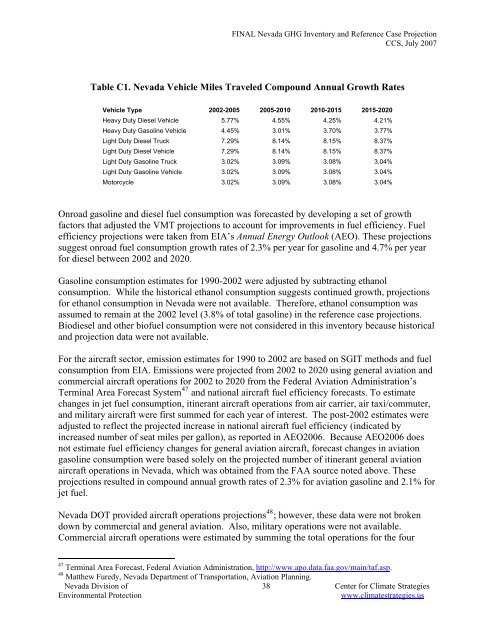Nevada Greenhouse Gas Inventory and Reference Case Projections
Nevada Greenhouse Gas Inventory and Reference Case Projections
Nevada Greenhouse Gas Inventory and Reference Case Projections
Create successful ePaper yourself
Turn your PDF publications into a flip-book with our unique Google optimized e-Paper software.
FINAL <strong>Nevada</strong> GHG <strong>Inventory</strong> <strong>and</strong> <strong>Reference</strong> <strong>Case</strong> Projection<br />
CCS, July 2007<br />
Table C1. <strong>Nevada</strong> Vehicle Miles Traveled Compound Annual Growth Rates<br />
Vehicle Type 2002-2005 2005-2010 2010-2015 2015-2020<br />
Heavy Duty Diesel Vehicle 5.77% 4.55% 4.25% 4.21%<br />
Heavy Duty <strong>Gas</strong>oline Vehicle 4.45% 3.01% 3.70% 3.77%<br />
Light Duty Diesel Truck 7.29% 8.14% 8.15% 8.37%<br />
Light Duty Diesel Vehicle 7.29% 8.14% 8.15% 8.37%<br />
Light Duty <strong>Gas</strong>oline Truck 3.02% 3.09% 3.08% 3.04%<br />
Light Duty <strong>Gas</strong>oline Vehicle 3.02% 3.09% 3.08% 3.04%<br />
Motorcycle 3.02% 3.09% 3.08% 3.04%<br />
Onroad gasoline <strong>and</strong> diesel fuel consumption was forecasted by developing a set of growth<br />
factors that adjusted the VMT projections to account for improvements in fuel efficiency. Fuel<br />
efficiency projections were taken from EIA’s Annual Energy Outlook (AEO). These projections<br />
suggest onroad fuel consumption growth rates of 2.3% per year for gasoline <strong>and</strong> 4.7% per year<br />
for diesel between 2002 <strong>and</strong> 2020.<br />
<strong>Gas</strong>oline consumption estimates for 1990-2002 were adjusted by subtracting ethanol<br />
consumption. While the historical ethanol consumption suggests continued growth, projections<br />
for ethanol consumption in <strong>Nevada</strong> were not available. Therefore, ethanol consumption was<br />
assumed to remain at the 2002 level (3.8% of total gasoline) in the reference case projections.<br />
Biodiesel <strong>and</strong> other biofuel consumption were not considered in this inventory because historical<br />
<strong>and</strong> projection data were not available.<br />
For the aircraft sector, emission estimates for 1990 to 2002 are based on SGIT methods <strong>and</strong> fuel<br />
consumption from EIA. Emissions were projected from 2002 to 2020 using general aviation <strong>and</strong><br />
commercial aircraft operations for 2002 to 2020 from the Federal Aviation Administration’s<br />
Terminal Area Forecast System 47 <strong>and</strong> national aircraft fuel efficiency forecasts. To estimate<br />
changes in jet fuel consumption, itinerant aircraft operations from air carrier, air taxi/commuter,<br />
<strong>and</strong> military aircraft were first summed for each year of interest. The post-2002 estimates were<br />
adjusted to reflect the projected increase in national aircraft fuel efficiency (indicated by<br />
increased number of seat miles per gallon), as reported in AEO2006. Because AEO2006 does<br />
not estimate fuel efficiency changes for general aviation aircraft, forecast changes in aviation<br />
gasoline consumption were based solely on the projected number of itinerant general aviation<br />
aircraft operations in <strong>Nevada</strong>, which was obtained from the FAA source noted above. These<br />
projections resulted in compound annual growth rates of 2.3% for aviation gasoline <strong>and</strong> 2.1% for<br />
jet fuel.<br />
<strong>Nevada</strong> DOT provided aircraft operations projections 48 ; however, these data were not broken<br />
down by commercial <strong>and</strong> general aviation. Also, military operations were not available.<br />
Commercial aircraft operations were estimated by summing the total operations for the four<br />
47 Terminal Area Forecast, Federal Aviation Administration, http://www.apo.data.faa.gov/main/taf.asp.<br />
48 Matthew Furedy, <strong>Nevada</strong> Department of Transportation, Aviation Planning.<br />
<strong>Nevada</strong> Division of 38 Center for Climate Strategies<br />
Environmental Protection<br />
www.climatestrategies.us
















